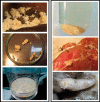Sterilization of Chrysomya putoria (Insecta: Diptera: Calliphoridae) eggs for use in biotherapy
- PMID: 25399429
- PMCID: PMC5633979
- DOI: 10.1093/jisesa/ieu022
Sterilization of Chrysomya putoria (Insecta: Diptera: Calliphoridae) eggs for use in biotherapy
Abstract
Large-scale, quality-controlled laboratory production of fly larvae is needed for biotherapy. The objective of this study was to assess the action of glutaraldehyde on the sterilization of Chrysomya putoria eggs by applying pharmaceutical sterility tests. Egg masses with 0.600 g were divided into three parts of 0.200 g, the eggs were separated using sterile distilled water, and the suspensions obtained were mixed with activated 2% glutaraldehyde solution. After 15-min contact, the suspensions were filtered through Whatman filter paper, and the glutaraldehyde residue obtained in the filtrate was neutralized by rinsing with Tryptone Soy Broth. The treated eggs were placed aseptically on Petri dishes containing gauze moistened with sterile saline solution. About 10% of the sterilized mass was transferred to test tubes containing Tryptone Soy Broth and Fluid Thioglycollate Broth. The tubes were incubated, respectively, at 22.5 and 35.0°C for 14 d to verify egg mass sterility. The plates containing the rest of the eggs (90%) were sealed with plastic film and kept in a climatized chamber at 30°C/d, 28°C per night, 60 ± 10% relative humidity, and under a 12-h light period to assess insect viability and survival. Each experiment was carried out in triplicate using a biological class II safety cabinet. No change in color or turgidity was observed with the agent tested, proving the sterility of the product and that there was no trace of contamination. Forty larvae (in three replications) in the periods of 12, 24, and 48 h after sterilization, when transferred to diet, produced larvae, pupae, and total viability similar to the control (larvae without sterilization). However, for the 72-h treatment, larvae and total viability were significantly lower than for the other treatments. There was no significant difference for the pupal stage. The product tested was shown to be efficacious for use as a sterilizer of C. putoria eggs for all the parameters assessed.
Keywords: glutaraldehyde treatment; larval therapy; screw worm; sterility test; wound.
© The Author 2014. Published by Oxford University Press on behalf of the Entomological Society of America.
Figures


Similar articles
-
Sterilization of blow fly eggs, Chrysomya megacephala and Lucilia cuprina, (Diptera: Calliphoridae) for maggot debridement therapy application.Parasitol Res. 2017 May;116(5):1581-1589. doi: 10.1007/s00436-017-5435-9. Epub 2017 Mar 30. Parasitol Res. 2017. PMID: 28361272
-
Biological behavior of Chrysomya putoria (Wiedemann, 1819) (Diptera: Calliphoridae) after refrigeration: Logistics for use in Biotherapy.An Acad Bras Cienc. 2023 May 29;95(suppl 1):e20220578. doi: 10.1590/0001-3765202320220578. eCollection 2023. An Acad Bras Cienc. 2023. PMID: 37255170
-
Efficacy of UV-C Ray Sterilization of Calliphora vicina (Diptera: Calliphoridae) Eggs for Use in Maggot Debridement Therapy.J Med Entomol. 2019 Jan 8;56(1):40-44. doi: 10.1093/jme/tjy140. J Med Entomol. 2019. PMID: 30137370
-
Sterilization of Lucilia sericata (Diptera: Calliphoridae) Eggs for Maggot Debridement Therapy.J Med Entomol. 2022 May 11;59(3):1076-1080. doi: 10.1093/jme/tjac020. J Med Entomol. 2022. PMID: 35187572
-
A new method for the production of sterile colonies of Lucilia sericata.Med Vet Entomol. 2017 Sep;31(3):299-305. doi: 10.1111/mve.12232. Epub 2017 Apr 12. Med Vet Entomol. 2017. PMID: 28402593
Cited by
-
Investigation of antimicrobial effects of treated Lucilia sericata larvae extract on bacteria.Iran J Microbiol. 2018 Dec;10(6):409-416. Iran J Microbiol. 2018. PMID: 30873269 Free PMC article.
-
A human tissue-based assay identifies a novel carrion blowfly strain for maggot debridement therapy.Sci Rep. 2022 Jul 16;12(1):12191. doi: 10.1038/s41598-022-16253-9. Sci Rep. 2022. PMID: 35842442 Free PMC article.
-
Sterilization of blow fly eggs, Chrysomya megacephala and Lucilia cuprina, (Diptera: Calliphoridae) for maggot debridement therapy application.Parasitol Res. 2017 May;116(5):1581-1589. doi: 10.1007/s00436-017-5435-9. Epub 2017 Mar 30. Parasitol Res. 2017. PMID: 28361272
References
-
- ANVISA (Agência Nacional de Vigilância Sanitária) , Gomes S. M., Verotti M., Melo J. R., Santi L. . 2007. . Glutaraldeído em estabelecimentos de assistência à saúde : fundamentos para a utilização. ( http://www4.anvisa.gov.br/base/visadoc/CP/CP%5B17400-1-0%5D.PDF ) .
-
- Baer W. S . 1931. . The treatment of chronic osteomyelitis with the maggot (larva of the blowfly) . J Bone Jt. Surg .13 : 438 – 475 . - PubMed
-
- Barbosa L. S., Jesus D. M. L., Aguiar-Coelho V. M. . 2004. . Longevidade e capacidade reprodutiva de casais agrupados de Chrysomya megacephala (Fabricius, 1794) (Díptera: Calliphoridae) oriundos de larvas criadas em dieta natural e oligídica . Rev. Bras. Zoociências 6 : 207 – 217 .
-
- Barbosa L. S., Couri M. S., Coelho V. M. A. . 2010. . Performance of the parasitoid Nasonia vitripennis (Walker) (Hymenoptera, Pteromalidae) using as host Cochliomyia macellaria (Fabricius) (Diptera, Calliphoridae) under different exposition times . Rev. Bras. Entomol .54 : 125 – 129 .
-
- BioStat 5.2 . 2012. . Instituto de Desenvolvimento Sustentável Mamirauá . Amazonia, Brasil: . ( http://www.mamiraua.org.br/downloads/programas ) .
Publication types
MeSH terms
Substances
LinkOut - more resources
Full Text Sources
Other Literature Sources

